Quantum computing is ushering in an era of monumental change, promising unparalleled advancements alongside significant risks. The potential of quantum computers to process information at unprecedented speeds heralds both opportunities and challenges, notably in the realm of cybersecurity. The European Union’s strategic embrace of quantum security is rooted in addressing these imminent risks head-on. This focus stems from the anticipated rise of quantum machines capable of breaking current cryptographic protocols, posing a threat to sensitive data worldwide and underscoring the urgent need for robust quantum-safe solutions.
Understanding the Quantum Security Challenge
The core concern associated with quantum security lies in the transformative power of quantum computing, which may soon exceed 10,000 qubits. In practical terms, this could render encryption methods like RSA and AES vulnerable to quantum attacks within the next fifteen years. This phenomenon, known as ‘Q-Day,’ prompts a race for adaptation and innovation to safeguard data. The EU’s comprehensive quantum strategy tackles these issues, aiming to both catalyze economic growth and preemptively mitigate cybersecurity threats through initiatives like Quantum Key Distribution (QKD) that promise secure communication.
Background and Importance
Europe’s commitment to leading in the quantum sector by 2030 is anchored in its Quantum Strategy, a vital plan aimed at fostering a resilient quantum infrastructure. This approach is driven by the need to counter quantum-enabled threats even as quantum technology advances rapidly. The strategy’s broader significance extends beyond technical security; it represents a decisive move to maintain sovereignty in technological innovation, ensuring that the EU remains competitive on the global stage. As political and economic landscapes increasingly hinge on digital security, the importance of this endeavor cannot be understated.
Research Methodology, Findings, and Implications
Methodology
To explore quantum security preparedness, the EU’s strategy employs a variety of projects and collaborations, including the European Quantum Communication Infrastructure (EuroQCI). EuroQCI is a cornerstone element focusing on the deployment of quantum networks across Europe. Member states are actively involved in establishing national terrestrial networks, using national and multinational projects to advance QKD technology. These efforts are bolstered by a robust European supply chain dedicated to developing quantum components essential for network security.
Findings
The research reveals significant progress in the deployment of secure quantum networks and the testing of quantum-safe communication technologies. Notable initiatives include pilot projects that facilitate encrypted communications in sensitive sectors like healthcare and government. The strategy also includes efforts from 26 EU Member States to set up their regional networks. These networks demonstrate the potential for widespread application and depict a promising path towards a fully interconnected quantum-secure communication landscape by 2030.
Implications
The findings underscore a continental shift towards quantum security, with the EU setting a benchmark for global standards. The strategy’s implications are far-reaching, influencing both technological adoption and geopolitical dynamics. By investing in quantum infrastructure, Europe positions itself as a vanguard in tech governance, which may drive innovation across various sectors, from secure data sharing to financial services. However, the slow pace of organizational adoption remains an issue, necessitating more concerted efforts to usher businesses into this new era of security.
Reflection and Future Directions
Reflection
The study of the EU’s quantum strategy exposes challenges both in coordination among member states and in scaling technologies from pilot to full deployment. The gradual shift from existing systems to quantum-safe methods requires significant investments and cross-border collaborations. Encountering these hurdles has facilitated a greater understanding of the scalar and logistical aspects of pioneering such an initiative.
Future Directions
Future research will likely focus on refining quantum technologies, addressing unresolved questions, and expanding applications beyond communication infrastructures. As the threat landscape evolves, there is an opportunity to delve deeper into quantum-safe algorithms and explore how quantum advancements can complement, rather than compete with, existing digital systems. Encouraging broader organizational adoption of quantum security tools remains imperative, as does refining educational initiatives to cultivate quantum expertise.
Conclusion
In summary, the EU’s proactive engagement with quantum security challenges is more than a defensive measure; it is a strategic maneuver with long-term technological and economic ramifications. While significant strides have been made toward preparing for a post-quantum era, much work remains to be done. Future efforts will need to prioritize standardizing quantum-safe methods across industries and ensuring all sectors are on board with this digital transformation. Maintaining momentum in research and collaboration will be key to navigating the evolving quantum landscape, securing data integrity in the face of emerging threats.






